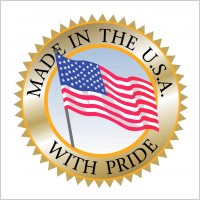|
"How do you
get a $16500 tonearm for $1900? Let me suggest that you compare the Pete Riggle Woody(tm) with the Durand Telos. "
-Pete Riggle
"I could never afford to
purchase a Schroeder, and The Woody is every bit as good. Every parameter
you could want is easily adjustable; and it's so beautiful, and so musical too."
- Ted Danowski
Woody™
Universal TM Tonearms
Woody
Universal Tonearms TM are exceptionally musical. They provide a full array of adjustability, adaptability,
and convenience features never before offered. They can be optimized to work with any standard mount cartridge.
(If a Woody tonearm is needed for use with SME style interchangeable headshells, for example the Ortofon SPU cartridges,
check out the Woody SPU tonearm: http://www.vtaf.com/id102.html )
Compare the Woody
Universal Tonearm (tm) at $1900 to the Schroeder and Reed tonearms in the $4000 to $7500 range, and the
Durand arms priced at $8500 and $16,500. Dream no more. The Woody tonearms are extremely musical, and anticipate
all user needs at a price many audiophiles can afford. In addition to exceptional sonics, the Woody(tm) tonearms provide easy setup, and remarkable ease of adjustment. With
the record in play it is easy to adjust VTA, azimuth, and anti-skating force. All adjustments are made with thumbscrews.
Hex wrenches (Allen wrenches) are not required. Woody Universal Tonearms allow
the user to change headshells and headshell adjuster plates, and to change counterweight mass, to optimally perform
with the specified, compliance, mass, and tracking force of any cartridge. Headshells and headshell adjuster
plates in brass, aluminum, and wood (different masses) are provided with the Woody tonearm. Multiple counterweights and counterweight
boosters are provided to balance the weight of any cartridge and its preferred headshell and headshell adjuster plate.
A setup guide is provided in the Owner's Manual covering the setup for a wide range of cartridges. Woody
Universal Tonearms are the most easily adjustable and most easily adaptable (to any
standard mount cartridge) tonearm product ever offered. Owners invariably comment on the musicality of Woody tonearms. Attention has been paid in the design of Woody
Universal Tonearms to every detail affecting sound quality, ease of adjustment, adaptability to various cartridges, and
ease of setup and use. Nothing has been overlooked. Examples: Extensive use of wood and brass, the StringTheoryTM string
bearing, oil damping, high quality Teflon insulated phono wire, Cardas cartridge clips, and excellent RCA connectors
all contribute to a more musical experience. Installation of cartridges on the Woody tonearm is easier and more risk
free than for any other tonearm. The ergonomic finger lift makes hand cueing easier and more secure than for other
tonearms. The continuous wire run eliminates intermediate electrical connections, for better sound. Standard effective lengths for Woody Universal TonearmsTM are
229 mm (9 inches, SME length), 240 mm (9.45 inches, Rega length), 254 mm (10 inches) and 310 mm (12.2 inches). We have also
provided arms in the effective lengths of 356 mm (14 inches), and 406 mm (16 inches).
Please check out the following reviews:
John Hoffman's review in
Positive Feedback Online:
http://www.positive-feedback.com/Issue56/stringtheoryarm.htm
Beneath that beautiful French polished wood lies a remarkable
bit of creative thinking in regards to the obstacles presented by analog playback and neatly executed engineering solutions.
If you value a hand crafted product and the passion and integrity of a designer, then I would suggest you give the String
Theory arm serious consideration."
"The defining characteristic of the String Theory arm is its combination
of proper tonal color and its unflappable expression of micro dynamics that make up music. What this translates to is this:
music has a robust and fleshed out tonal balance, yet the fine detail which makes it realistic is not lost in the pleasing
texture of the music."
Thad Aerts review, Part 1, in hifizine
http://www.hifizine.com/2011/06/pete-riggle-engineering-stringtheory-woody-tonearm/
"For being a rather sophisticated design, the Woody was a snap to set-up
and the whole process (alignment included) took me a little over an hour. Again, I already had the VTAF installed (which makes
a big difference in terms of time) and I made periodic minor tweaks as I listened to music. Still, Riggle is to be applauded
for the thought that he put into the arm’s design – not to mention its stunning aesthetics ."
Thad Aerts review, Part 2, in hifizine
http://www.hifizine.com/2011/09/riggle-stringtheory-tonearm-part-2/
Thad compares the Woody to his modified Rega RB250, which uses Incongnito wire, the Pete Riggle VTAF, and
the Pete Riggle Counterweight for the Common Man, all of which are dramatic improvements to the RB250:
"The
best analogy I can muster to describe the differences I heard between the two tonearms was that the Rega (greatly
improved by modifications) was like watching a really high quality tubed television. Then, take the same program material
you just viewed and watch it on a state of the art plasma or LCD or whatever. There is really no contest. The Woody brought
more air to whatever it played while also raising the level of definition. There were many times while listening where I wondered
how much better it could really get short of better equipment downstream. It is, hands down, the best tonearm I’ve
ever had the pleasure of hearing. Throw in its stellar good looks and ridiculous ease of set-up and you have a clear
winner."
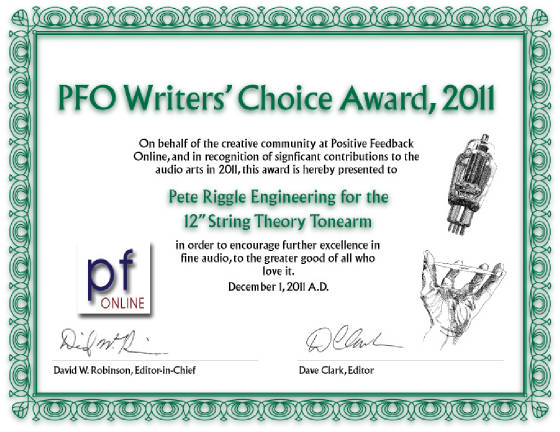
|
| Writer's Choice Award from Positive Feedback Online |

|
| Jeff Award from reviewer Jeff Day |
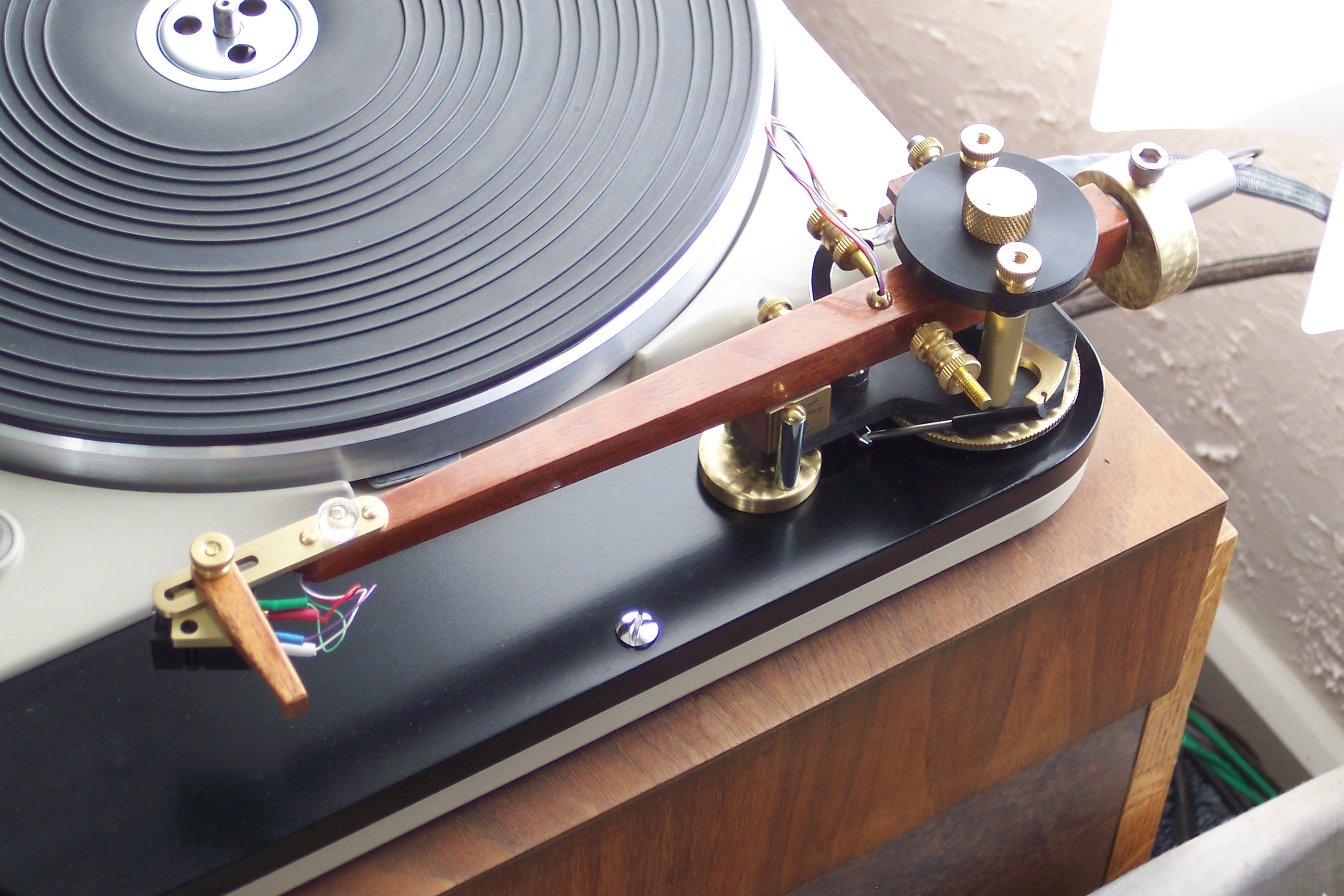
|
| Woody with Brass Headshell and Headshell Adjuster Plate: Easy Overhang and Alignment Adjustment |
Features:
Acclaimed playback performance and features. Exemplary
at any price. Remarkable at $1900 U.S.
French polished wood tonearm wand for controlled resonances and great beauty. Solid
brass hardware (aluminum or rosewood headshell hardware where required for low and medium effective mass). Ergonomically configured
wood fingerlift for sure control when hand cueing. Precision lift/lower mechanism. Magnetic arm lock/rest.
Incorporates the proven, popular, and well received
VTAF™ (Vertical Tracking Angle on the Fly) for easy VTA Adjustment with the record in play.
Incorporates the VTAF Teflon Upgrade.
Incorporates
the AZOF™ system (AZimuth On the Fly) for easy azimuth adjustment with the record
in play.
Incorporates the ASOF™ system
(Anti-Skate on the Fly) for easy anti-skate adjustment with the record in play.
Incorporates the proven and well received Counterweight
for the Common Man™.
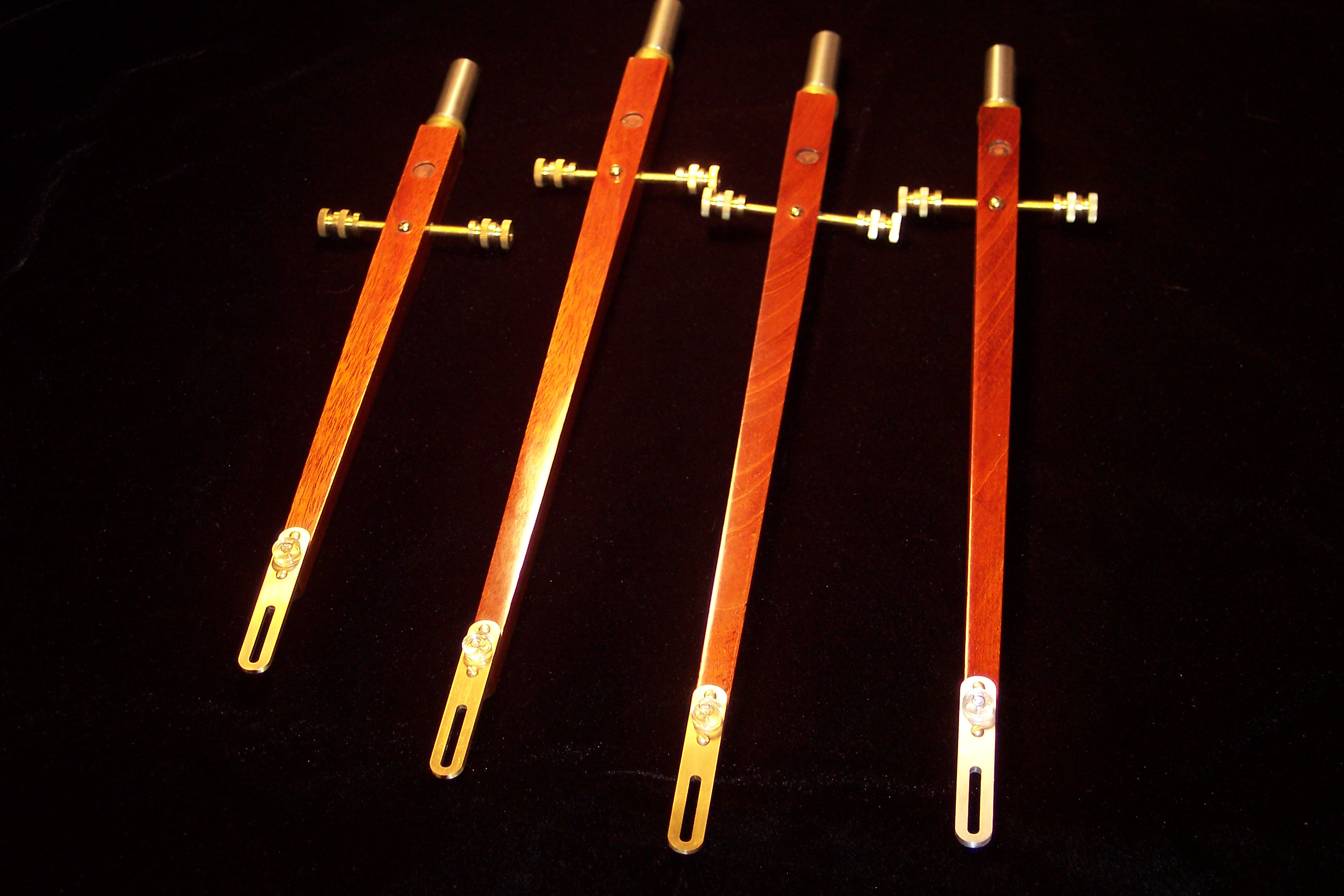
|
| Mahogany Wands with Brass Headshell, Adjuster Plate, and Bubble Vial |
Headshell bubble level indicates adjustments to azimuth and
VTA
String Theory (tm) unique string unipivot
bearing system provides chatter free low bearing friction and smoothly adjustable anti-skate. Bearing is radially
stiff for accurate tuneful bass performance.
Snubber
integral with AZOF system provides tonearm handling comparable to a gimbal bearing tonearm.
Oil damping cup allows operation with or without
oil damping.
Continuous wire from
Cardas brand cartridge clips to RCA plugs is standard. XLR connectors available at no extra cost. Ultra flexible copper
wire. Robust terminations. Upon request the Woody tonearm can be set up for independent external phono cables provided
by user.
By interchanging headshells
and headshell adjuster plates of different material densisties, and counterweights to provide the correct balance, the
Woody tonearm can be set up for the optimum 8 Hz resonance frequency with most cartridges. The laws of
physics dictate that the higher effective mass associated with lower resonance frequency provides reduced headshell
vibration from stylus oscillation, giving improved clarity, inner detail, nuance, air and bass response. This
is true across the entire audible spectrum. The chosen resonant frequency (8 Hz) is sufficiently high to avoid problems with
footfall vibrations and record warps.
Removable
headshell and long headshell leads allows easy cartridge installation (user not required to stand
on head) in conjunction with continuous tonearm wire.
Easily adapts to shallow, medium, or high platters.
All
adjustments are easily made using knurled nuts or thumbscrews. Allen wrenches (hex wrenches) and
other special tools are not required. Easy adjustments include single knurled nut for overhang and alignment,
single thumbscrew for counterweight (tracking force adjustment), easy VTA adjustment with knurled wheel, easy azimuth adjustment
with lever, easy lateral balance adjustment with knurled nuts, easy anti-skate adjustment with knurled knob and locking thumbscrew,
and easy height adjustment of lift/lower mechanism with locking thumbscrew. Note that the VTA, Azimuth, and
Anti-Skate Adjustments can be made on the fly (with the record in play). Accessories Provided with the Woody Universal Tonearm:
Provided accessories include: Detailed
owners’ manual specific to the parameters of each String Theory Woody tonearm, mounting distance gage, alignment gage,
overhang gage, high viscosity oil for damping cup, syringe for transferring high viscosity oil, and additional headshells,
headshell adjuster plates, and counterweights to allow the user to set up to optimally play any cartridge with standard
mounting centers.
The Woody arms
are modeled by computer, and subsequently tested, to verify that each will balance and provide the intended
tracking force with the intended cartridge(s) and will have correct effective mass to achieve the desired resonant frequency.The
tonearm wand has a square cross section which tapers from the pivot to the headshell. While it is common in the industry
to design tonearms for a resonant frequency somewhere around 12 Hz, theory dictates (and we believe on the basis of experience)
that more massive arms, with a resonant frequency closer to 8 Hz, sound better. This is because across
the audible frequency spectrum, arms with lower resonant frequency respond less to needle talk vibrations than arms with
higher resonant frequency. Tracking problems with record warps and footfalls do not usually occur with a tonearm
resonant frequency of 8 Hz and above.
With low compliance cartridges (roughly 5 to 8 compliance units) the Woody
will typically use a brass headshell and headshell adjuster plate. With medium compliance cartridges (roughly 10 to
16 compliance units) the Woody will typically use an aluminum headshell and headshell adjuster plate. With high compliance
cartridges (roughly 18 to 30 compliance units) the Woody will typically use a Spanish Cedar headshell and headshell
adjuster plate. The $1900 USD price includes all three headshells and headshell adjuster plates, as well as
multiple counterweights to set up for optimal playback with all cartridges.
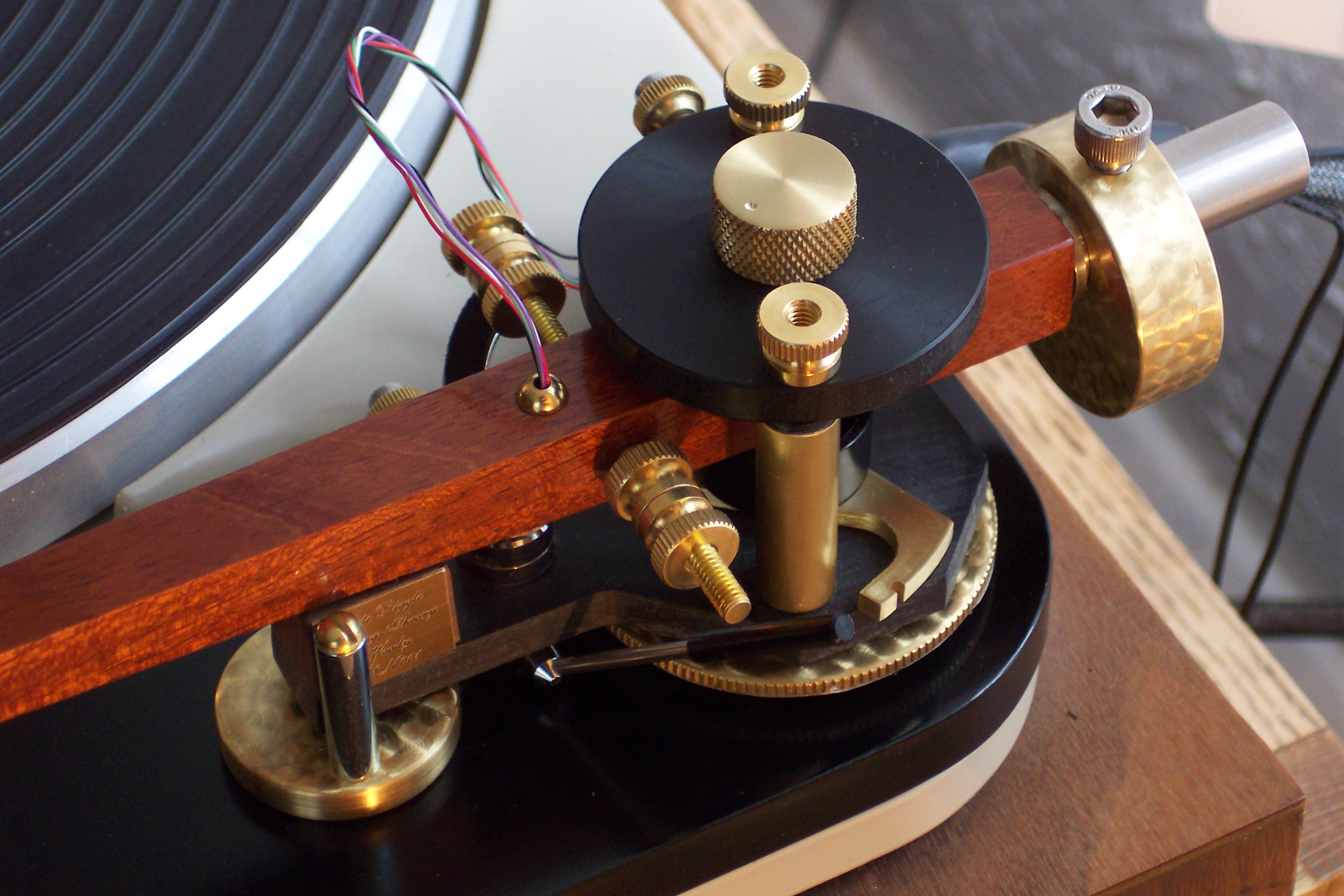
|
| Bearing System with VTAF, AZOF, ASOF,Height Adjustable Lift/Lower, and Counterweight Adjuster |
More Detail:
At this point we have extensive experience with Woody tonearms ranging in length from 9 to 16 inches. These
tonearms are all very musical. We have provided users with a number of Woody tonearms in various lengths
and for various cartridges. We are getting glowing reports.
VTA on the Fly (VTAF): These tonearms use the proven VTAF (Vertical Tracking
angle on the Fly) system, allowing the VTA to be dialed in to the sweetest angle while the record is in play
as the user listens to the effect of VTA. The VTAF also isolates the tonearm system from the armboard. Many VTAF users
have attested to the remarkable sonic benefits of isolation provided by the VTAF. With the VTAF, a thin adjuster
wheel running on fine threads moves the tonearm pedestal up or down to change VTA. The VTAF Teflon Upgrade, which lines the
bearing surfaces of the VTAF with Teflon, and improves sonics and smoothness of operation, is standard with the Woody tonearms.
Azimuth On the Fly (AZOF): Also
incorporated into the Woody tonearms is a system which allows the azimuth to be to be dialed in to the sweetest condition
while the record is in play, as the user listens to the effect of azimuth. AZOF is achieved by a manually adjusted lever
on the lower platform which controls the position of a vertical axis snubber pin directly under the tonearm pivot. The vertical
axis snubber pin loosely engages a small aluminum channel secured under the tonearm wand, with the channel axis parallel to
the tonearm axis. Once the preferred azimuth has been dialed in, it is desirable in theory, but actually unnecessary in practice,
to adjust the lateral balance of the arm to achieve a balance such that the snubber pin is not in continuous contact with
the channel.
Anti-Skate On the Fly (ASOF): Anti-skate is set using a blank
record or blank space in a lead-out groove. With the record turning the user rotates the anti-skate knob at the
center of the top plate. This puts a twist into the bearing string, creating an outward skating tendency to balance the
inward skating tendency caused by stylus drag. Anti-skate is properly set when the stylus tends to stay put or move slowly
outward when placed on a blank space on the surface of the record. For purchasers who wish, we can provide the Pete Riggle
Anti-skate Measurement System (PRAMS) free of charge.
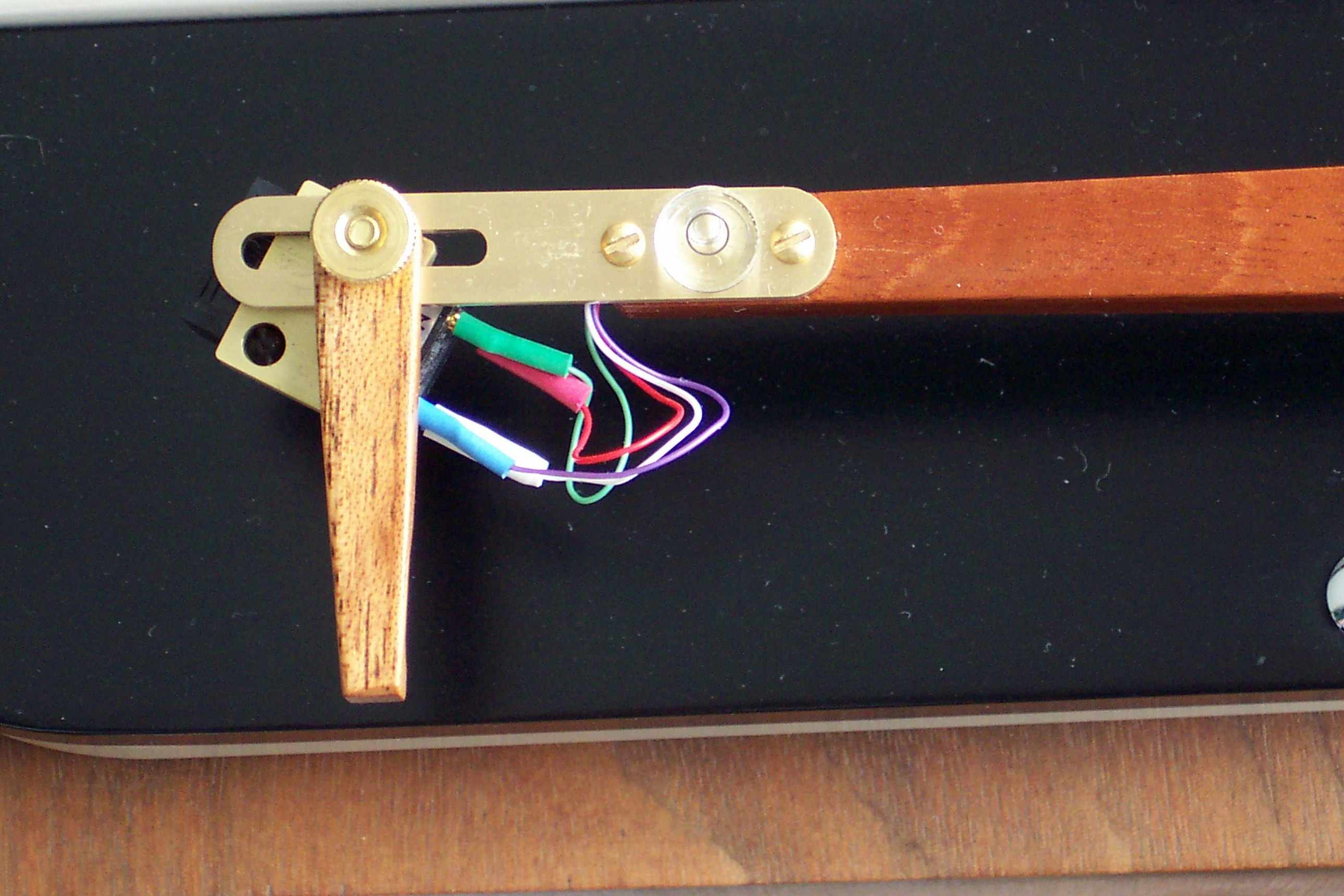
|
| Headshell & Adjuster Plate, Ergonomic Lift, Bubble Vial, Easily Adjust Overhang and Alignment . |
The arm for each customer is modeled by computer, and subsequently
tested, to verify that the arm will balance and provide the intended tracking force with the intended cartridge(s)
and will have correct effective mass to achieve the desired resonant frequency.The tonearm wand has a square cross section
which tapers from the pivot to the headshell. While it is common in the industry to design tonearms for an arm/cartridge
resonant frequency somewhere around 12 Hz, theory dictates (and we believe on the basis of experience) that more massive
arms, with a resonant frequency closer to 8 Hz, sound better. This is because across the audible
frequency spectrum, arms with lower resonant frequency respond less to needle talk vibrations than arms with higher
resonant frequency. Tracking problems with record warps and footfalls do not usually occur with a tonearm resonant
frequency of 8 Hz and above.
The design philosophy is to use wood
wherever possible, and brass and Delrin ™ where wood is not as practical as desired. Where necessary for reduced
tonearm effective mass, aluminum or wood can be used for headshell components. This philosophy has resulted a
remarkably balanced tonal character which makes real music. The question might arise "My Rega arm with
the VTAF and the CCM sounds wonderful. Can the Woody tonearms actually sound better?" The answer is that while the Rega
arms with the VTAF and CCM are truly excellent, the Woody arms are more musical.
The Woody design uses a uniquely configured
string unipivot suspension with snubbing to make tonearm handling the same as with conventional bearings. Tonearm
handling is made more convenient with the use of a long, light, wood, ergonomically shaped finger lift. A
precision lift/lower device is standard. The tonearm rest/lock uses a strong magnet to attract a steel target under the tonearm
wand. The tonearm is held down securely against vertical forces, but lifts nicely off the magnet when put into play by
the user.
The uniquely configured string unipivot
is stiff in the horizontal plane, resulting in excellent bass response. The string unipivot bearing is suspended
from a knurled brass knob at the center of the upper platform. Anti-skate tendency can be adjusted by rotating this knob.
The knob is locked with a thumbscrew when in the correct position.
All Woody tonearm adjustments are easy
to make without reliance on hex keys. We object to the common use of hex keys and special tools for tonearm adjustment.
Hex keys are so easy to misplace, and once misplaced, it is a nuisance to find the right size. VTA is adjusted with
the VTAF. AZimuth On the Fly is adjusted with the AZOF lever. Tonearm lateral balance is adjusted with knurled brass
balance weights. The Counterweight for the Common Man provides tracking force adjustment with a knurled thumbscrew to lock
the counterweight in place. The headshell provides easy alignment using only one knurled nut. Anti-skate
tendency is dialed in by rotating a knurled brass knob on the upper platform, allowing Anti-Skate On the Fly (ASOF). Even
the lift/lower device is easily adjusted upward and downward, using a knurled thumb-screw to lock the device in place.
For arms with adjustable VTA this is an important feature. The Woody is probably the most easily adjusted tonearm
ever developed.
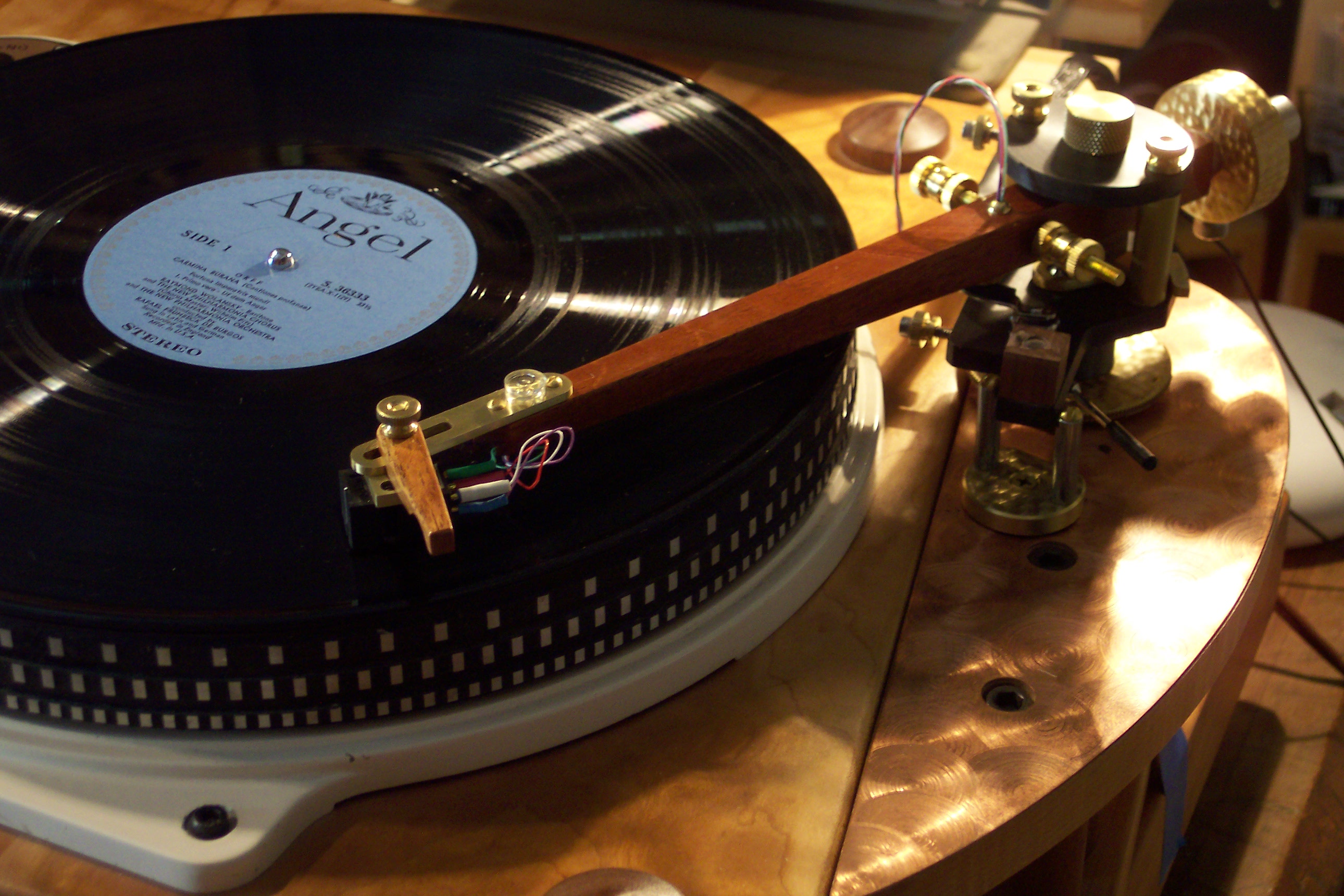
|
| The Pleasure of Vinyl Playback with the Woody |
A tiny circular bubble level is
made integral with the headshell adjuster plate. This tiny bubble level provides the user with a quick visual
determination of azimuth and VTA. A lateral balancer is provided to get perfect lateral balance at the desired azimuth
once azimuth has been dialed in by the AZOF system.
The standard wiring configuration provides
a continuous run of 36 gage Teflon insulated, silver plated, stranded copper wire between the cartridge and the
phono stage. We've tried a number of wire products. So far this is the best we've found. The wire harness
is shielded by a small diameter thin walled brass tube along the length of the tonearm, unshielded at the compliance loop
(similar to VPI tonearms), and shielded with foil and a drain wire from the compliance loop to the RCA plugs. The shield is
not connected at the RCA plugs or at the cartridge. A long ground wire connects the wiring harness shield system
to the chassis ground at the phono amplifier. A short ground wire is provided in the event the user needs to connect the turntable
to the grounding system (this is important for tables with metal motor boards, such as the Thorens TD124, The Garrard 301,
or the Lenco tables). Configurations allowing user selected RCA patch cables are optional. The Woody is designed
for ease of wiring and rewiring (not that rewiring will ever be required). The extreme flexibility of the wire used
minimizes changes in anti-skate force as the arm sweeps across the record.
In our listening room we are using
a 12 inch Woody with a Denon DL103 cartridge, and are getting very musical results. The 12 inch
nominal Woody has a length of 310 mm (12.2 inches) from stylus to pivot, with an overhang of 13.1 mm (.516 inches) for the
Baerwald alignment. This particular arm was set up with an effective mass of about 30 grams, to which one must add the cartridge
mass to get the total mass. Cartridge mounting is standard with screws spaced 0.5 inches on centers. This arm sounds
wonderfully musical with the DL103, and may sound even better with some of the more sophisticated cartridge products.
For higher compliance cartridges the
arm effective mass can be lowered, still keeping the resonant frequency around 8 Hz, by using aluminum or Spanish
Cedar for the headshell, the headshell adjuster plate, or both.
Woody tonearms are available in lengths
to allow easy replacement of older arm designs. Typical arms in the 9 to 10 inch range vary from a length of 229
mm to 254 mm. Woody arms are available to replace arms of any length. We have had great success with 12, 14, and 16
inch arms.
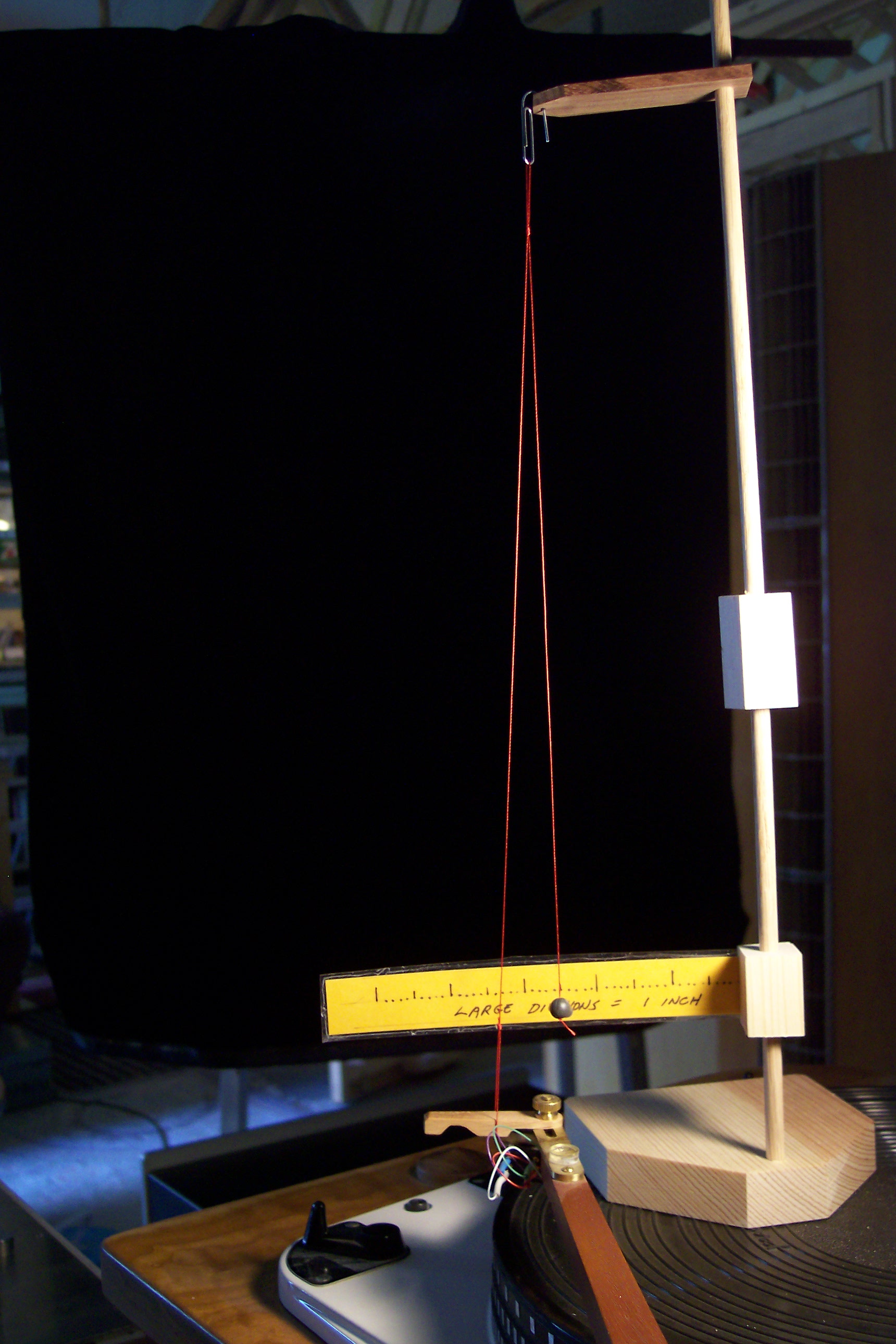
|
| Pete Riggle Anti-Skate Measurement System; Compare to Wally Skater |
The wood tonearm wand is finished in
French polish, rubbed on in many sessions. French polish is legendary for bringing out the beauty of wood.
There is nothing like it. Lacquered Brass finish is used for brass parts, with an optional Smokey Silver finish ($120 U.S.
extra). At present the wood being used for most Woody tonearms is aged Spanish cedar, which looks and finishes like various
species of mahogany, but is lower in density.
Interest in this family of tonearms
is running quite high. The list price is $1900 USD. We suggest comparing the Woody arms to Schroeder
and Reed arms in the $4000 U.S. to $4500 U.S. range, and to Durand arms in the $7900 U.S. to $16500 range.
Because these tonearms are labor intensive, and I am a one man shop, I will never be able to produce more than one of these
tonearms every two weeks.The purchaser is free to return the arm within 90 days, for a full refund of the purchase
price. Actual shipping and insurance will be charged, running about $35 U.S. to U.S. destinations, and about $120
to Europe.
At
the original $1600 price the Woody tonearm came with one headshell and one headshell adjuster plate in a material weight
density (brass, aluminum, or wood) required to accommodate one cartridge compliance range (low, medium, or high). At
the current $1900 price, headshells and headshell adjuster plates are provided in brass, aluminum, and wood, along with
counterweights as required, to accommodate widely varying cartridge parameters.
I will be happy to accept an order
with a $200 down payment. The current waiting period for delivery is one month. I prefer payment by PayPal,
but can accept a credit card on a U.S. bank, a personal check on a U.S. bank, a money order, or an international money order.
Please advise if you find yourself
with unanswered questions or concerns. I can be contacted by email at peteriggle@msn.com, or by phone at 509 582
4548. I am often in the shop, but away from the office phone. If you call and get the answering machine, please leave a brief
message with your telephone number and/or email address.

|
| Pete Riggle at Rocky Mountain Audio Fest |
Woody Tonearm Specifications
List Price, Woody Universal Tonearm: $1900 US in the Lacquered Brass finish. The Woody
Universal Tonearm can be set up to play any standard mount cartridge (1/2 inch screw spacing) in any compliance range.
The compliance ranges are Low (5 to 8 compliance units), Medium (10 to 16 compliance units), or High (18 to 30
units). The Woody Universal Tonearm comes with headshells and headshell adjuster plates of three different materials (brass,
aluminum and Spanish Cedar), allowing the arm to maintain the preferred resonant frequency of 8 Hz using cartridges
with compliances ranging from 5 to 28 compliance units. Add $120 US if the Smokey Silver finish is required. List
Price, Woody SPU Tonearm: $2000 in the Lacquered Brass finish. When mounted per the instructions, the included sliding
mounting plate of the Woody SPU Tonearm will allow adjustment to play both SPU Type G and Type A cartridges, as well
as low or medium compliance standard mount cartridges (1/2 inch screw spacing) using a customer supplied universal headshell.
Add $120 if the Smokey Silver finish is required.
Range of cartridge masses accomodated: 3 to 17 grams
Range of cartridge compliances accomodated: 5 to 30 compliance units for the Woody Universal tonearm, 5 to 15 compliance
units for the Woody SPU tonearm.
Mounting hole dimensions: 1.25 inches (31.75 mm) diameter for the Woody
Universal Tonearm
Mounting slot dimensions: 1.25 inch by 2.5 inch slot for Woody SPU Tonearm
(1.125 inch by 2.5 inch slot by special request)
Finishes: Metal parts in Lacquered Brass or Smokey
Silver; wood parts finished with hand applied French polish
Tonearm effective lengths for Woody Universal Tonearm:
229 mm (9 inches), 240 mm (9.45 inches), 254 mm (10 inches), or 310 mm (12.2 inches). Other lengths as specified by customer,
up to 16 inches. Tonearm effective length for Woody SPU Tonearm: 317.5 mm (12.5 inches)
Tonearm effective mass: As required to achieve 8 Hz resonant frequency for specific cartridge or cartridges
Headshell
materials: Three headshells, brass, aluminum, and Spanish Cedar
Headshell adjuster plate materials: Three
headshell adjuster plates, brass, aluminum, and Spanish Cedar
Headshell mounting screw and nut: Brass and Nylon
Cartridge
mounting screws/nuts included: 2-56 brass
Cartrige screw spacing: 1/2 inch
Finger Lift: Ergonomically
configured Spanish Cedar
Tonearm wand material: Spanish Cedar is standard. Other woods as practical by special
arrangement with customer.
Counterweight: Brass Counterweight for the Common Man ™, modified for low
center of gravity
Counterweight stub: Hollow stainless steel
Pivot Bearing: Unique Stringtheory(tm)
string unipivot is stiff laterally and vertically
Tonearm handling: Snubber provides handling similar to standard
gimbal bearings
Oil damping: standard
Tonearm wire and cable are continuous from the Cardas cartridge
clips to the connectors at the phono stage
Adjustments:
— VTA on the Fly, using patented
VTAF(tm) mechanism, including VTAF Teflon Upgrade
— Azimuth On the Fly, using unique AZOF(tm) mechanism
— Anti-Skate On the Fly, with ASOF(tm) system (rotate string bearing knurled support knob)
— Anti-skate lock: set screw with knurled knob
— Tracking force: slide counterweight,
lock with knurled thumb screw
— Overhang and cartridge alignment, using knurled nut with slotted headshell
adjuster plate
— Lateral Balance coarse adjustment: rotate counterweight; fine adjustment, lateral
balance weights
— Lift/lower mechanism height adjustment: set screw with knurled knob
Adjustment tools: Knurled knobs eliminate the need for adjustment tools (hex wrenches not required)
Tonearm Rest
and Lock: Brazilian rosewood tonearm rest with magnetic tonearm hold-down
Indicator: Azimuth and VTA indicated
by circular bubble level on headshell adjuster plate
Setup tools included:
— circle template for
mounting hole
— mounting distance gage (mm scale and caliper)
— overhang gage
—
alignment protractor
|
